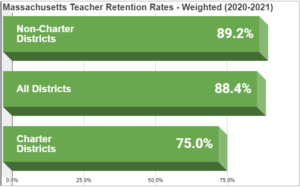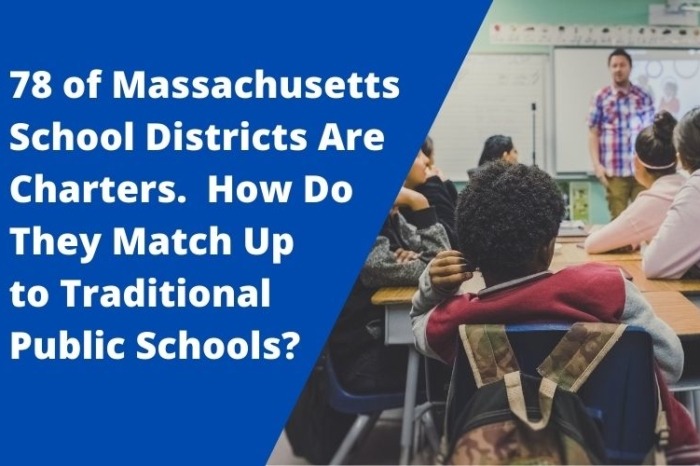A Conversation about Massachusetts Charter Schools: Retention Rate and Age Trends Among Public Educators
Massachusetts was home to 400 school districts in the 2020-2021 school year, 78 of which are charters. Established by the Massachusetts Education Reform Act of 1993, public charter schools in the Commonwealth have delivered on their promise of access, outcomes, and opportunity.
In 2018, Pioneer Institute Senior Fellow Cara Stillings Candal published The Fight for the Best Charter Public Schools in the Nation. She suggests that the success of charters lies within a model of social entrepreneurship, allowing for autonomy in curriculum, hiring, and management while being held accountable for outcomes. If a school doesn’t perform well, its charter is revoked.
Using statewide educator reports from the Massachusetts Department of Elementary and Secondary Education (DESE), Pioneer set out to create a narrative around retention and age statistics for the Commonwealth’s teachers. The main findings were that, while the average weighted retention rate for teachers in charter districts was 75 percent, traditional district schools averaged 89.2 percent. As for age, charter educator populations were significantly younger than their district counterparts.
The key characteristic of charters within this trend is that the autonomy that grants charter schools flexibility in who teaches. Echoing the concept on which they are based, charters are empowered to make decisions that stray from the norm, but they must back the decisions with results. The Centre for Economic Policy Research (CEPR) highlighted some of the impacts of the competitive education market back in November.
While the unions that are very powerful in most districts make it difficult to remove underperforming educators, charters have more autonomy to hire and fire, and can even hire qualified instructors before they receive a license. The drawback of working in such a novel and fast-paced environment is that charter teachers often have less generous salaries and benefits without the pros of union protections and bargaining power.
All in all, CEPR research finds that this model benefits the teaching labor market as a whole, allowing unlicensed educators to get a start with their often diverse backgrounds. Furthermore, a figure comparing attrition to quality finds that charters lose their worst and best performing teachers more than district schools, helping to “weed out” ineffective teachers from the workforce while understanding that the best educators may move to traditional school systems. Numerous studies cited by CEPR also break down the narrative that the existence of charters harms district schools; their growth is found to have no negative impact on the strength and quality of neighboring traditional options.
This downloadable teacher retention rate excel sheet provides a breakdown of the number of teachers in each school district as of October 1, 2020 with a corresponding retention rate for those educators staying on in the same role. This first figure presents its main conclusions – that charter districts have lower retention rates on average.
Figure 1: Massachusetts Teacher Retention Rates – Weighted (2020-2021)

Source: Massachusetts Department of Elementary and Secondary Education “Staffing Retention Rates” Report (5/13/2021)
*Figure 1 excludes one non-charter district, Gosnold, which did not report retention data in 2020.
While charter school teacher retention rates lag behind non-charter districts by nearly 15 percentage points, Catherine Worth at the Fordham Institute noted that these mere statistics do not specify departing teachers’ performance levels, not to mention position changes or school district-swaps – charter-to-charter or charter-to-district. The goal of charter programs is to build up and keep skilled educators while encouraging turnover patterns that enhance school performance. While some of the diverse and exceptionally skilled teachers who leave charters are eventually hired in district schools, the latter point may also spark a beneficial conversation about adopting a more accountable model.
Below, Figure 2 maps out the percentages and counts of FTE teachers in all Massachusetts charter and non-charter districts by age category for the 2020-2021 school year. Breakdowns for counts and percentages at individual school districts are available in the excel spreadsheet linked above.
Figure 2: Massachusetts Teacher Populations by Age (2020-2021)
Source: Massachusetts Department of Elementary and Secondary Education “2020-21 Educators by Age Groups Report (District) – Full-time Equivalents – Teacher” (4/15/2020)
*The above data and summary statistics do not include the eight school districts which were not reported in Mass. DESE’s “2020-21 Educators by Age Groups Report (District) – Full-time Equivalents – Teacher”. They are: Boston Preparatory Charter Public; Boston Renaissance Charter Public; Collegiate Charter School of Lowell; Learning First Charter Public School; Old Sturbridge Academy Charter Public School; Sabis International Charter; Greenfield Community Virtual District; TEC Connection Academy Commonwealth Virtual School District.
The data do include the five school districts which report less than one full-time equivalent teacher. They are: Boston Day and Evening Academy Charter; Commonwealth Charter School of Cambridge; Dudley Street Neighborhood Charter; Gosnold; New Salem-Wendell.
In sum, there are 400 school districts in Massachusetts: 322 are non-charter and 78 are charter. The figure above includes 320 non-charter and 72 charter districts.
The visual shows that charter teachers tend to be younger than their district school peers. Of the 2,600 FTE charter school teachers in Massachusetts, 52.1 percent were under the age of 33, more than double the 22.4 percent of traditional public school teachers. While the 33-40 category is close between the two school types, the difference widens in higher age categories.
Could the age gap between charter and district school teachers explain lower retention rates? While it’s difficult to prove direct causation, a joint project by the then Spencer Foundation and Public Agenda, Charter Schools In Perspective, broke down some other interesting comparisons.
Charter school teachers averaged 3.6 years at their current school and had nine years of total experience in the field, compared to 8.1 and 14 total years for district school teachers. Additionally, 37 percent of charter school teachers had a master’s degree, compared to 48 percent at traditional public schools, and charter teachers were more likely to be racially diverse While public school teachers were more likely to take professional development courses in their subject matter and computer literacy, charter teachers took classroom management, student discipline, teaching english as a second language, and disability accommodations development in higher numbers.
The charter school debate was reignited in late 2016 when Question 2 asked voters if Massachusetts should raise the cap on the number of charters that could be granted per year. While the initiative lost by a 62-38 percent margin, national Education Next 2019 polling data indicates that the general public supports charter schools by a 48-39 percent margin.
The data shows that understanding what a charter school is increases support for them. Seventy-eight percent of respondents answered incorrectly or not sure when asked if charters were allowed to hold religious services, and 73 percent were wrong or did not know if charters could charge tuition. Most astoundingly, a specific question in Education Next’s 2016 edition found that only 28% supported charter schools when the question was first raised, but when a two-sentence explanation of what a charter school was was provided, support nearly doubled to 52%.
This July, Massachusetts public schools ranked number one in the country in both quality and safety according to a comprehensive WalletHub study. Retention rates and age brackets definitely show interesting trends in comparing traditional public schools to charter public schools. But more importantly, they create a narrative about what is intrinsically different between the two options. Parents should consider what unique strengths each individual district has, the quality of their educators, and the success of their students.
For more on charter school success in Massachusetts and the 50,000+ students they serve, check out the Massachusetts Charter Public School Association and their 2018-2019 fact sheet.
Jack Landsiedel is a Roger Perry Government Transparency Intern at the Pioneer Institute for Summer 2021. He is a rising junior at the University of Maryland, College Park with a major in Government & Politics and minors in Public Leadership and Sustainability Studies.



